1997 HONDA ODYSSEY brake light
[x] Cancel search: brake lightPage 145 of 241

Owner Maintenance Checks
You should check the following items at the specified intervals. If
you are unsure of how to perform any check, turn to the page given. Engine oil level — Check every
time you fill the fuel tank. See
page 112.
Engine coolant level — Check the
radiator reserve tank every time
you fill the fuel tank. See page 113.
Windshield washer fluid — Check the level in the reservoir monthly.
If weather conditions cause you to
use the washers frequently, check
the reservoir each time you stop
for fuel. See page 156.
Automatic transmission — Check the fluid level monthly. See page
157.
Brakes — Check the fluid level
monthly. See page 158. Tires — Check the tire pressure
monthly. Examine the tread for
wear and foreign objects. See page
171.
Lights — Check the operation of
the headlights, parking lights,
taillights, high-mount brake light,
turn signals, brake lights, and
license plate lights monthly. See
page 177.
MaintenanceProCarManuals.comMain Menu Table of Contents s t
Page 176 of 241
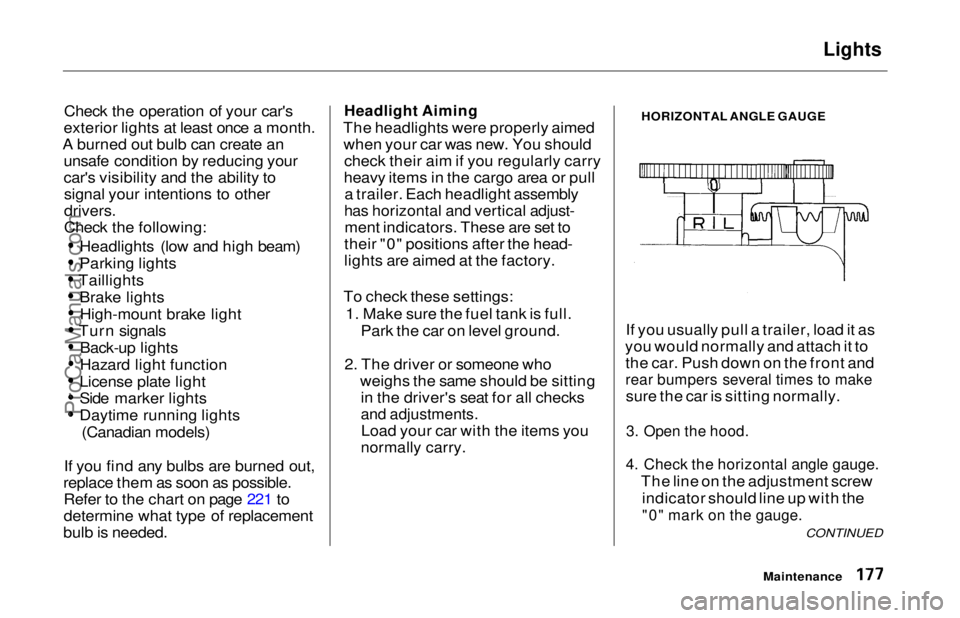
Lights
Check the operation of your car's
exterior lights at least once a month.
A burned out bulb can create an unsafe condition by reducing your
car's visibility and the ability tosignal your intentions to other
drivers.
Check the following:
Headlights (low and high beam)
Parking lights
Taillights Brake lightsHigh-mount brake light
Turn signals
Back-up lights
Hazard light function
License plate light
Side marker lights
Daytime running lights (Canadian models)
If you find any bulbs are burned out,
replace them as soon as possible. Refer to the chart on page 221 to
determine what type of replacement
bulb is needed.
Headlight Aiming
The headlights were properly aimed when your car was new. You should check their aim if you regularly carry
heavy items in the cargo area or pull a trailer. Each headlight assembly
has horizontal and vertical adjust-
ment indicators. These are set to
their "0" positions after the head-
lights are aimed at the factory.
To check these settings: 1. Make sure the fuel tank is full. Park the car on level ground.
2. The driver or someone who weighs the same should be sittingin the driver's seat for all checks
and adjustments.
Load your car with the items you
normally carry.
HORIZONTAL ANGLE GAUGE
If you usually pull a trailer, load it as
you would normally and attach it to the car. Push down on the front and
rear bumpers several times to make
sure the car is sitting normally.
3. Open the hood.
4. Check the horizontal angle gauge.
The line on the adjustment screwindicator should line up with the
"0" mark on the gauge.
Maintenance
CONTINUEDProCarManuals.comMain Menu Table of Contents s t
Page 183 of 241
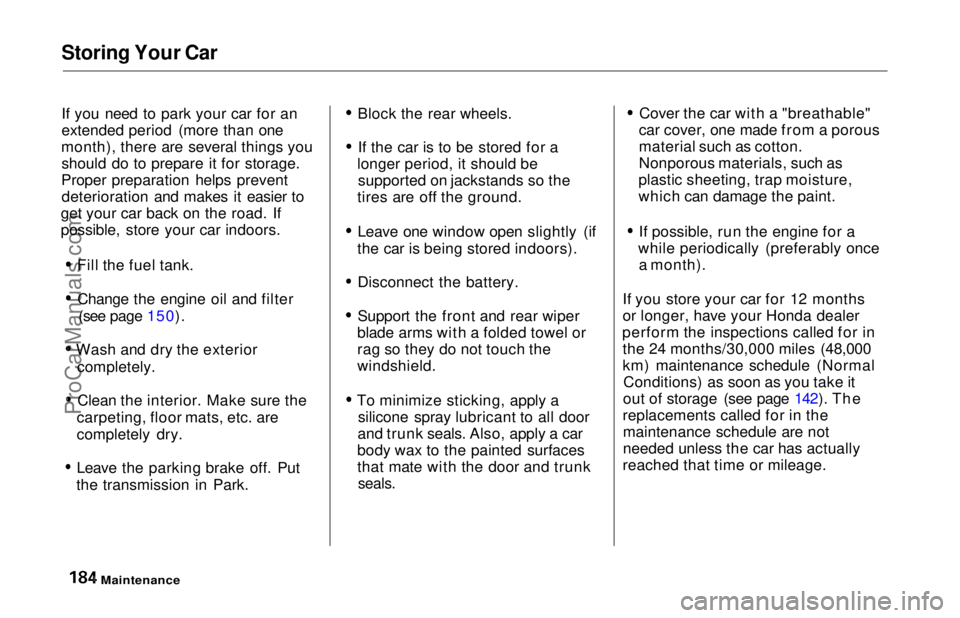
Storing Your Car
If you need to park your car for an
extended period (more than one
month), there are several things you should do to prepare it for storage.
Proper preparation helps prevent deterioration and makes it easier to
get your car back on the road. If
possible, store your car indoors.
Fill the fuel tank.Change the engine oil and filter (see page 150).
Wash and dry the exterior completely.
Clean the interior. Make sure the
carpeting, floor mats, etc. are
completely dry.
Leave the parking brake off. Put
the transmission in Park. Block the rear wheels.
If the car is to be stored for a
longer period, it should be supported on jackstands so the
tires are off the ground.
Leave one window open slightly (if
the car is being stored indoors).
Disconnect the battery.
Support the front and rear wiper
blade arms with a folded towel or
rag so they do not touch the
windshield.
To minimize sticking, apply a silicone spray lubricant to all door
and trunk seals. Also, apply a car
body wax to the painted surfaces
that mate with the door and trunk
seals.
Cover the car with a "breathable"
car cover, one made from a porous
material such as cotton.
Nonporous materials, such as
plastic sheeting, trap moisture,
which can damage the paint.
If possible, run the engine for a
while periodically (preferably once a month).
If you store your car for 12 months
or longer, have your Honda dealer
perform the inspections called for in the 24 months/30,000 miles (48,000
km) maintenance schedule (Normal Conditions) as soon as you take it
out of storage (see page 142). The
replacements called for in the maintenance schedule are not
needed unless the car has actually
reached that time or mileage.
MaintenanceProCarManuals.comMain Menu Table of Contents s t
Page 193 of 241
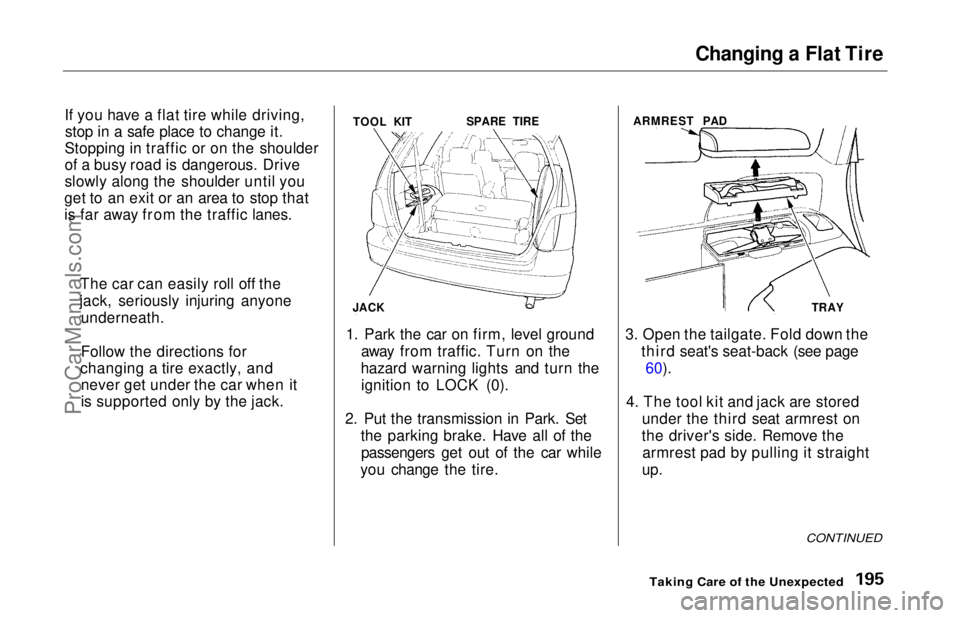
Changing a Flat Tire
If you have a flat tire while driving, stop in a safe place to change it.
Stopping in traffic or on the shoulder
of a busy road is dangerous. Drive
slowly along the shoulder until you
get to an exit or an area to stop that
is far away from the traffic lanes.
1. Park the car on firm, level groundaway from traffic. Turn on the
hazard warning lights and turn the ignition to LOCK (0).
2. Put the transmission in Park. Set the parking brake. Have all of thepassengers get out of the car while
you change the tire. 3. Open the tailgate. Fold down the
third seat's seat-back (see page60).
4. The tool kit and jack are stored under the third seat armrest on
the driver's side. Remove the armrest pad by pulling it straight
up.
CONTINUED
Taking Care of the Unexpected
The car can easily roll off the
jack, seriously injuring anyone underneath.
Follow the directions for
changing a tire exactly, and never get under the car when it
is supported only by the jack. TOOL KIT
JACK SPARE TIRE
ARMREST PAD
TRAYProCarManuals.comMain Menu Table of Contents s t
Page 200 of 241
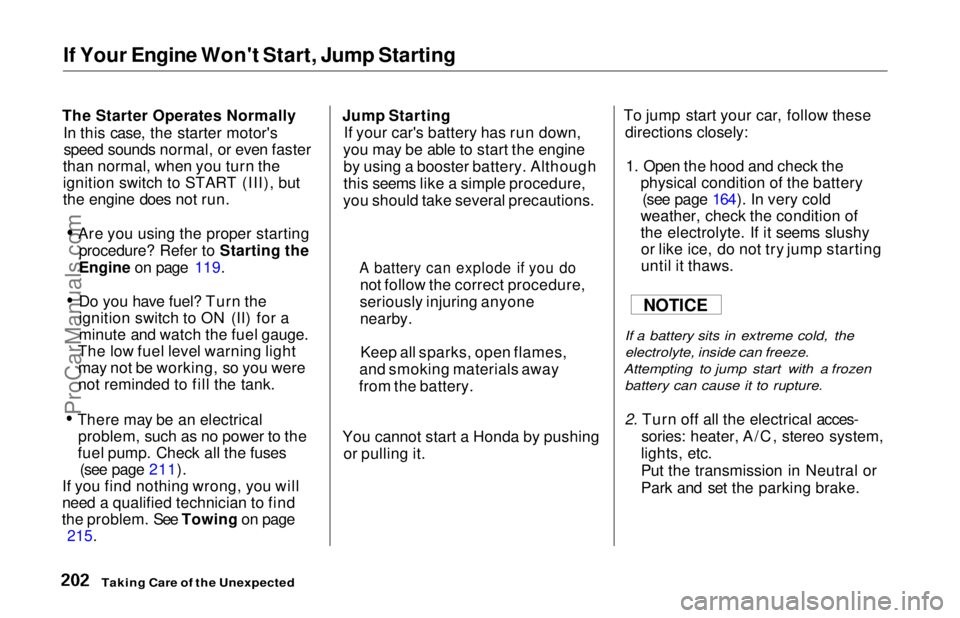
If Your Engine Won't Start, Jump Starting
The Starter Operates Normally In this case, the starter motor'sspeed sounds normal, or even faster
than normal, when you turn the
ignition switch to START (III), but
the engine does not run.
Are you using the proper startingprocedure? Refer to Starting the
Engine on page 119.
Do you have fuel? Turn the
ignition switch to ON (II) for a
minute and watch the fuel gauge.
The low fuel level warning light may not be working, so you were
not reminded to fill the tank.
There may be an electrical problem, such as no power to the
fuel pump. Check all the fuses (see page 211).
If you find nothing wrong, you will
need a qualified technician to find
the problem. See Towing on page
215.
Jump Starting
If your car's battery has run down,
you may be able to start the engine by using a booster battery. Although
this seems like a simple procedure,
you should take several precautions.
You cannot start a Honda by pushing or pulling it. To jump start your car, follow these
directions closely:
1. Open the hood and check the physical condition of the battery(see page 164). In very cold
weather, check the condition of
the electrolyte. If it seems slushy or like ice, do not try jump starting
until it thaws.
If a battery sits in extreme cold, the electrolyte, inside can freeze.
Attempting to jump start with a frozen battery can cause it to rupture.
2. Turn off all the electrical acces-
sories: heater, A/C, stereo system,
lights, etc.
Put the transmission in Neutral or
Park and set the parking brake.
Taking Care of the Unexpected
A battery can explode if you do
not follow the correct procedure,
seriously injuring anyone nearby.
Keep all sparks, open flames,
and smoking materials away
from the battery.
NOTICEProCarManuals.comMain Menu Table of Contents s t
Page 218 of 241
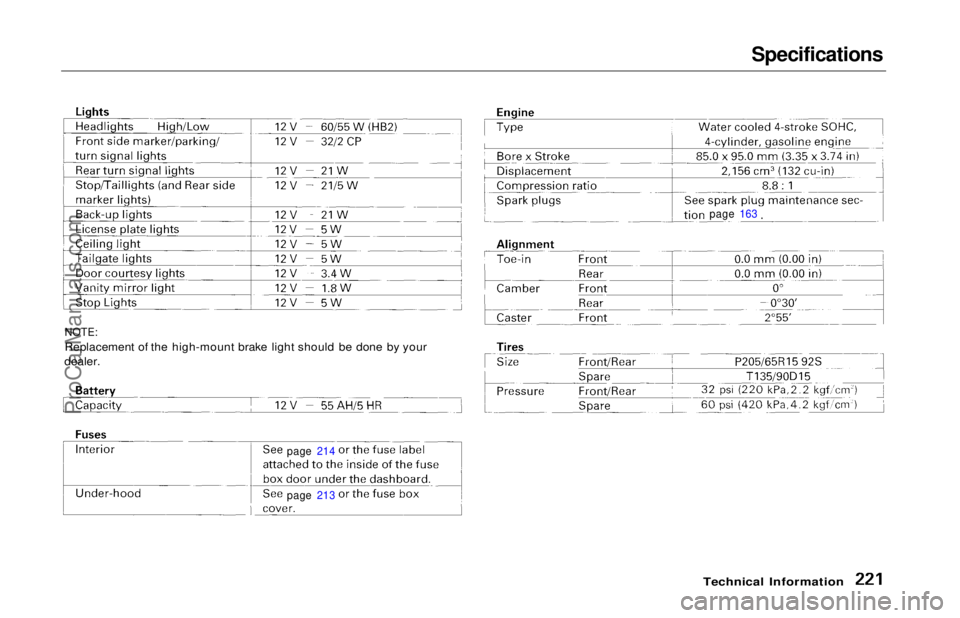
Specifications
Technical Information
NOTE:
Replacement of the high-mount brake light should be done by your
dealer.
page 214
page 213 page 163ProCarManuals.comMain Menu Table of Contents s t
Page 233 of 241
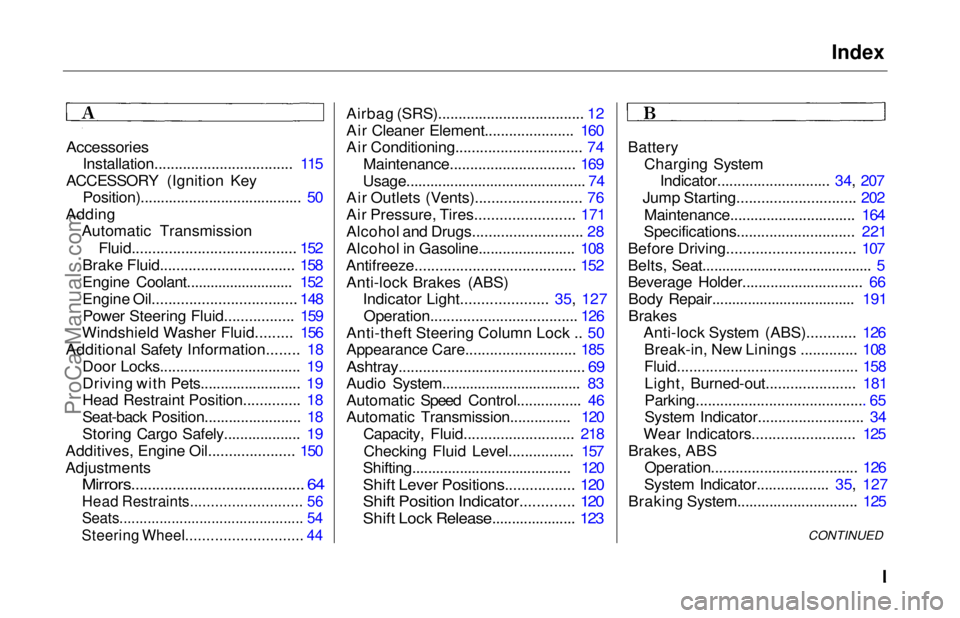
Index
Accessories
Installation.................................. 115
ACCESSORY (Ignition Key Position)........................................ 50
Adding Automatic Transmission
Fluid........................................ 152
Brake Fluid................................. 158
Engine Coolant........................... 152
Engine Oil................................... 148 Power Steering Fluid................. 159
Windshield Washer Fluid......... 156
Additional Safety Information........ 18 Door Locks................................... 19
Driving with Pets......................... 19
Head Restraint Position.............. 18
Seat-back Position........................ 18
Storing Cargo Safely................... 19
Additives, Engine Oil..................... 150
Adjustments
Mirrors.......................................... 64
Head Restraints........................... 56
Seats.............................................. 54
Steering Wheel............................ 44
Airbag (SRS).................................... 12
Air Cleaner Element...................... 160
Air Conditioning............................... 74
Maintenance............................... 169
Usage............................................. 74
Air Outlets (Vents).......................... 76
Air Pressure, Tires........................ 171
Alcohol and Drugs........................... 28
Alcohol in Gasoline........................ 108
Antifreeze....................................... 152 Anti-lock Brakes (ABS) Indicator Light..................... 35, 127
Operation.................................... 126
Anti-theft Steering Column Lock .. 50
Appearance Care........................... 185
Ashtray.............................................. 69
Audio System................................... 83
Automatic Speed Control................ 46
Automatic Transmission............... 120 Capacity, Fluid........................... 218
Checking Fluid Level................ 157
Shifting........................................ 120
Shift Lever Positions................. 120
Shift Position Indicator............. 120
Shift Lock Release..................... 123
Battery
Charging SystemIndicator............................ 34, 207
Jump Starting............................. 202
Maintenance............................... 164
Specifications............................. 221
Before Driving............................... 107
Belts, Seat........................................... 5
Beverage Holder.............................. 66 Body Repair.................................... 191
Brakes
Anti-lock System (ABS)............ 126
Break-in, New Linings .............. 108
Fluid............................................ 158
Light, Burned-out...................... 181
Parking.......................................... 65
System Indicator.......................... 34
Wear Indicators......................... 125
Brakes, ABS Operation.................................... 126
System Indicator.................. 35, 127
Braking System.............................. 125
CONTINUEDProCarManuals.comMain Menu s t
Page 234 of 241
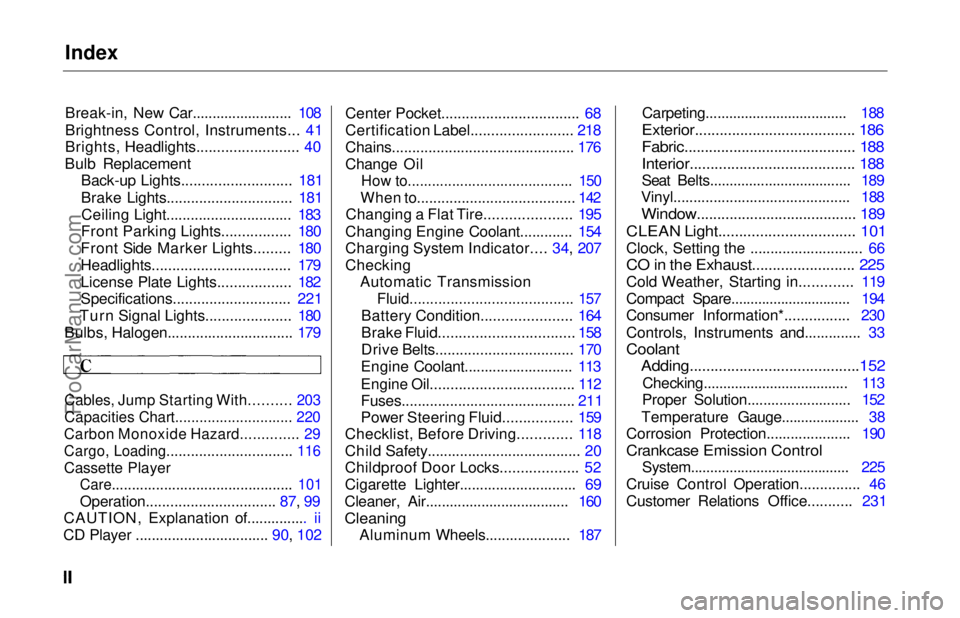
Index
Break-in, New Car......................... 108
Brightness Control, Instruments... 41
Brights, Headlights......................... 40
Bulb Replacement Back-up Lights........................... 181
Brake Lights............................... 181
Ceiling Light............................... 183
Front Parking Lights................. 180
Front Side Marker Lights......... 180
Headlights.................................. 179
License Plate Lights.................. 182
Specifications............................. 221
Turn Signal Lights..................... 180
Bulbs, Halogen............................... 179
Cables, Jump Starting With.......... 203
Capacities Chart............................. 220
Carbon Monoxide Hazard.............. 29
Cargo, Loading............................... 116
Cassette Player
Care............................................. 101
Operation................................ 87, 99
CAUTION, Explanation of............... ii
CD Player ................................. 90, 102 Center Pocket.................................. 68
Certification Label......................... 218
Chains............................................. 176
Change Oil
How to......................................... 150
When to....................................... 142
Changing a Flat Tire..................... 195
Changing Engine Coolant............. 154
Charging System Indicator.... 34, 207
Checking Automatic Transmission
Fluid........................................ 157
Battery Condition...................... 164
Brake Fluid................................. 158
Drive Belts.................................. 170
Engine Coolant........................... 113
Engine Oil................................... 112
Fuses........................................... 211
Power Steering Fluid................. 159
Checklist, Before Driving............. 118
Child Safety...................................... 20
Childproof Door Locks................... 52
Cigarette Lighter............................. 69
Cleaner, Air.................................... 160
Cleaning
Aluminum Wheels..................... 187 Carpeting.................................... 188
Exterior....................................... 186
Fabric.......................................... 188
Interior........................................ 188
Seat Belts.................................... 189
Vinyl............................................ 188
Window....................................... 189
CLEAN Light................................. 101
Clock, Setting the ............................ 66
CO in the Exhaust......................... 225
Cold Weather, Starting in............. 119
Compact Spare............................... 194
Consumer Information*................ 230
Controls, Instruments and.............. 33
Coolant
Adding.........................................152
Checking..................................... 113
Proper Solution.......................... 152
Temperature Gauge.................... 38
Corrosion Protection..................... 190
Crankcase Emission Control
System......................................... 225
Cruise Control Operation............... 46
Customer Relations Office........... 231ProCarManuals.comMain Menu s t